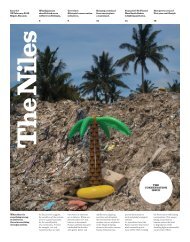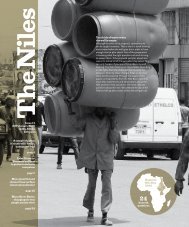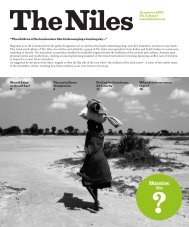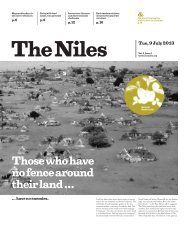We are what we eat
The food we eat literally determines who we are. It influences our physical, mental and even emotional well-being. From Egypt’s Cairo to Burundi’s Gitega, this issue of The Niles attempts to explore the essentials of food: from conflict and food insecurity to the sensory aspects of preparing and eating national dishes.
The food we eat literally determines who we are. It influences our physical, mental and even emotional well-being. From Egypt’s Cairo to Burundi’s Gitega, this issue of The Niles attempts to explore the essentials of food: from conflict and food insecurity to the sensory aspects of preparing and eating national dishes.
You also want an ePaper? Increase the reach of your titles
YUMPU automatically turns print PDFs into web optimized ePapers that Google loves.
One type of kisra is made of maize – common
in northern Sudan where farmers grow a lot of maize
– and another type is made of a different kind of
flour called fitarita, only grown in western Sudan.
I have tried to make kisra with my grandma many
times. Of course, hers was much better than mine,
but the recipe is actually straightforward: corn, salt,
water, barm or yeast. All the ingredients are mixed
together and left for a couple of hours and then
cooked on a flat pan, called saj, which is locally
produced to make kisra.
Same bread across the border
It was a surprise for me when I first tasted
the Ethiopian kisra at an Ethiopian friend’s house.
It showed me how we, in the Nile Basin countries,
in one way or another, share very similar customs,
traditions and food.
In Ethiopia, kisra is called injera. It’s similar
to the Sudanese kind except that it’s a little bit
thicker.
The food on any given Sudanese table is mostly
determined by where that table is set: the climate,
the vegetation and the animals of the area all greatly
determine which kind of food is consumed.
In the southern part of Sudan, for example, the
food is entirely different, as the soil is more fertile
and much more productive than in the northern
region. There, vegetables and fruits are regular
components of daily meals.
On the Red Sea coast in eastern Sudan, of course,
fish and seafood are most prevalent. In the western
part, millet is grown a lot and a component in most
of the dishes.
For more of grandma’s recipes have a look at the
‘Taste the Niles’ poster.
4.
Eat traditional, homemade foods
to stay healthy
Modern lives prefer fast, easily prepared food and
baby formula. But slow-cooked, old fashioned diets
are far healthier.
Martha Agama
Kampala, Uganda
Nutritionists have noted that dietary habits,
especially in urban areas, have shifted away from
high fibre, homemade foods to pre-prepared,
packaged and processed ready-to-eat foods. These
are easily accessible in fast food restaurant chains,
where people delight in the taste, unaware of the
health implications.
“In Uganda, the adoption of the Western eating
habits, modernisation and technology has
brought about changes in eating trends from
homemade meals to the increased consumption
of junk and processed foods,” explained Nicholas
Musisi, a Nutrition Researcher with Nutri-Worth
International.
Non-communicable diseases will account for
80 percent of the global disease burden by 2020,
according to the World Health Organization’s 2013
report. Of these non-communicable diseases, 70
percent will be the cause of death in developing
countries – dietary and nutritional cultures and
habits are a great contributor to such emerging
health threats.
Uganda’s Ministry of Health has listed
obesity, diabetes, cardiovascular diseases and
hypertension among the conditions that are
increasingly common due to the adoption of
unhealthy lifestyles. With lifestyle and cultural
changes, individuals are giving less and less
thought to what nutritional benefits or health
risks come with their dietary choices.
“For example, before we acquired maize mills,
families would grind maize with stones leaving
a high fibre content. Today, maize is highly refined,
wasting important nutrients,” added Musisi.
The advent of Genetically Modified Organisms
(GMOs) has stirred concerns by nutritionist and
health experts. In Uganda, most foods consumed
are organic, owing to an agriculturally dominant
economy. However, the introduction of GMOs
in agriculture raises fears about the nutritional
value of GM produce, and the impact of potentially
lower-quality food on human health.
“Although evidence linking genetically modified
foods to cancer is yet insufficient, the consumption
of fancy high-fat fast food popularly known as
junk food as well as processed foods have been
linked with heart disease, stroke, type 2 diabetes
and early death,” said Musisi.
With a growth in industrialisation, a shift has
been noted from traditional household food processing
and preservation methods such as sun drying,
salting, fermenting and grinding to more industrialised
methods that include the use of preservatives
in most foods. Preservatives, including nitrates,
have been linked to some types of cancer.
Passing down bad nutrition to children
The shift in our eating habits and cultures has
had an adverse impact on the health and nutrition
of infants as well. With more women working to
support families and the association of breastfeeding
with backwardness among young mothers, there
has been a notable decline in the breastfeeding
of infants.
“The modern young mothers prefer to introduce
infants to processed milk and other foods
to prevent their breasts from sagging,” explained
Dr Hanifa Bachou, a consultant nutritionist in
an article on the New Vision daily newspaper.
“This has had the adverse effect of leaving infants
with increased susceptibility to diseases such as
diarrhoea and measles.”
According to the Uganda Food and Nutrition
Policy 2013, the nation is generally food sufficient
with a wide range of crops including cereal grains
such as maize, millet and sorghum and root crops
including cassava, sweet potatoes and Irish potatoes.
Bananas are a staple food for a large section of the
country. Animal products like dairy and beef, poultry,
edible insects and a large variety of fish from inland
water sources are also available.
However, access to cheap convenience foods
by way of fast food restaurants and roadside food
vendors has reduced the prevalence of local markets
and the availability of indigenous and traditional
foods.
In the streets of Kampala, Uganda’s bustling
capital city, it is common to find trading centre
streets filled with food vendors who roast chicken,
goat meat, deep fry fish, chips and the famous ‘rolex’,
a flat, round, fried bread rolled together with fried
eggs. These vendors are the go-to places for inexpensive,
time-saving, and convenient fast foods.
The vendors operate freely, however, in generally
unsanitary conditions, raising concerns about
hygiene and food safety.
“No, the food is safe because it is served while
very hot, I buy my food from the streets most nights,
and I rarely have any stomach problems,” explained
a shopper who only introduced himself as Sam
when asked if he had concerns about purchasing
food from roadside vendors.
Benefits of traditional food
Setting aside cultural influences as a result
of modernisation, indigenous and traditional food
habits are mostly associated with a variety of health
benefits and even beauty. Many leafy foods and
vegetables are rich sources of vitamins, iron, fibre
and unsaturated fatty acids. Examples of such foods
include boo, hibiscus (malakwang), nakati, amaranth
(dodo), egg plants, and okra.
A great diversity exists within the ethnic cultures.
Traditionally, food defines social class, lifestyles
and gender roles. Each communities’ unique dishes
and methods of preparation and presentation reflects
their unique history, belief, lifestyle and values.
Inherent traditions may dictate what may or may
not be eaten by certain members of the community,
such as pregnant women. Ironically, the foods often
prohibited are highly nutritious.
Odoch Obwangamoi takes pride in maintaining
a healthy and nutritious diet by not deviating too
far from his native, Acholi indigenous eating habits.
The Acholi, a Nilotic ethnic group of Northern
Uganda, can be termed as a model community when
it comes to nutritious and sumptuous foods. They
have famous traditional meals with a variety of healthy,
leafy foods prepared with millet bread (kwon kal).
“Wherever I am, I always try to find my traditional
foods because nothing beats them when it comes
to taste and nutritional value,” said Obwangamoi.
“Our foods are made with lots of care, and some can
be prepared over long periods of time. The majority
of our foods are vegetables,” he added.
The Acholi are both pastoralists and farmers,
the cows are kept mostly for milk, with bush meat
providing protein. Cereal grains and lentils like
lapena, choroco, ngoo, greens like malakwanga and
boo make up the rich diet.
Malakwanga, a leafy vegetable also known as
Hibiscus sabdariffa is said to have healing properties
to increase breast milk for breastfeeding women
and building immunity by helping in the production
of white blood cells. White ants (ngwen), shea butter
and sesame (simsim) are also an important component
of the Acholi foods.
21
TN14_20191203_II.indd 21 2019/12/03 10:08

















